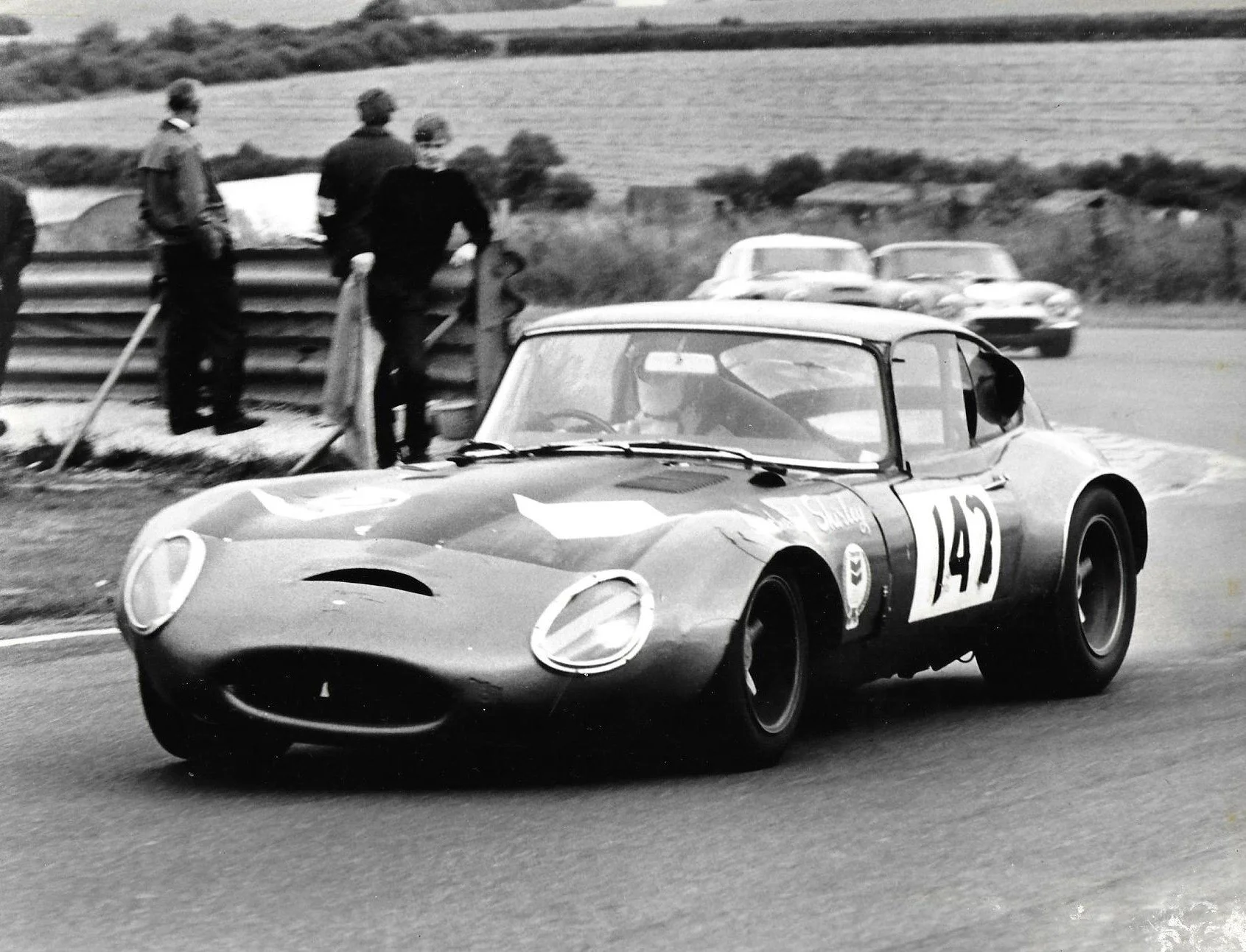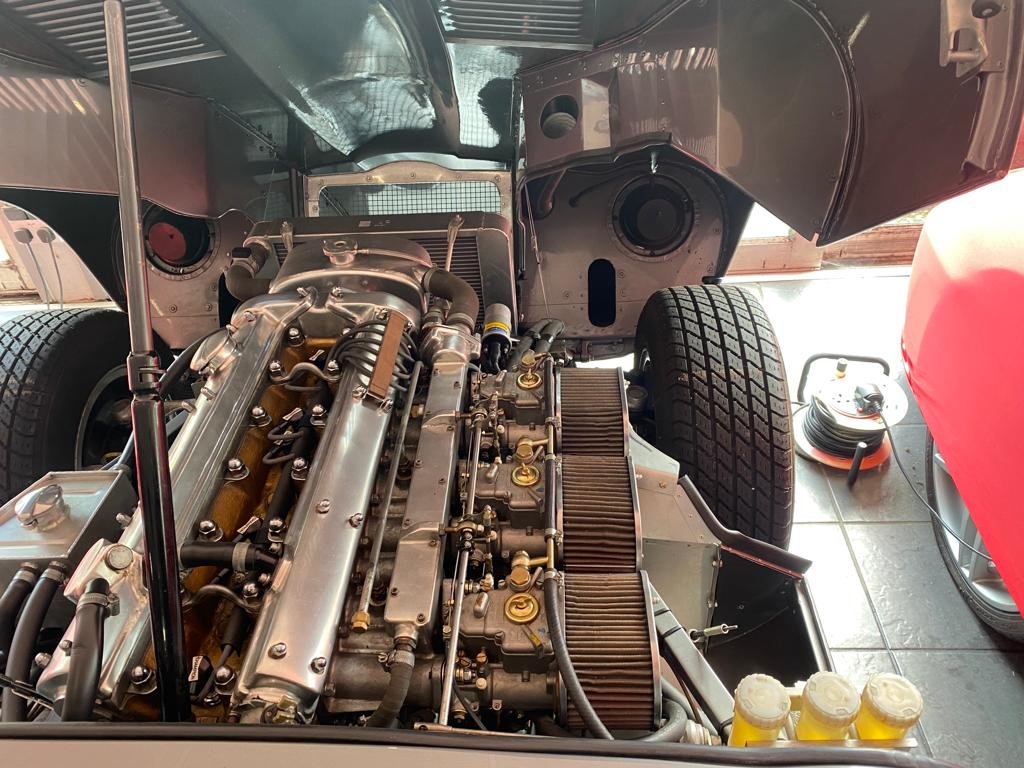1961 Jaguar E Type FHC Chassis no 860035 Semi Lightweight Flat Floor - The Spitfire E Type
- an historically significant car
The car as found in the specialist’s workshop
An addition to the fold has given me the chance to return a very famous Jaguar to the original condition, as raced in the 1960-70s.
by Howard Watts
The Spitfire E Type! This is chassis number 860035, supplied new to dealer Willetts of Eastbourne on 4 December 1961 and still wearing it’s original number plate JJK 195. Throughout the 1960s and early 1970s this well known E Type was used for club racing, modified to semi-lightweight spec, including alloy bonnet and doors, as well as the striking Perspex rear screen to replace the opening rear door.
It had become known as ‘the Spitfire Car’ because the second owner was a retired Spitfire pilot who fitted various dials and components from Spitfire planes, including a clock, oil temperature guage, interior light, alloy rudder pedals as passenger foot braces and even a tail-light from a Spit’ as the reversing light. It had disappeared in the early 1970s and had not been seen since
I came across the car in the workshop of a Jaguar specialist. Chassis no 860035 had been painstakingly partly rebuilt over the previous twenty-six years to recreate the first CUT 7, as raced by Dick Protheroe. It had been stripped internally and in the engine bay there is a brass plaque on the nearside engine frame from Dick Protheroe’s garage, County Motors, showing that the car passed through his hands at some stage. It was about 40% complete with the bodywork finished and painted. The remaining parts had been packed in crates and stored carefully for years.
The car as found
Dick Protheroe’s original racer, CUT 7
The plaque from County Motors
I was recently able to acquire the photographic records of the West Midlands Archer family and in particular momentoes including race programs and trophies of the late son, Peter Archer, depicting his racing exploits in chassis 860035 through the late 60s and early 70s. The family had run a car dealership in Shirley and Solihull, ‘Archers of Shirley’, pre and post war, firstly as a Standard Triumph agent and later including Austin/Morris and Jaguar. Peter’s father had, pre and post war, taken part in trials and hill climbs - evidenced by a number of trophies now also in my possession, and no doubt he had been an influence on his son’s racing activities. Some of the photos bear the logo ‘Archers of Shirley’ on the car’s flanks indicative of the family’s support.
It is evident from the photographs that the car was initially raced in the standard bodywork, albeit with the addition of various air scoops, but later substantially modified with extended raised wheel arches and lowered suspension (the difference illustrated by the two images below).
Amongst the treasures found in the family records was a small printed brochure, published by Jaguar Cars entitled ‘Tuning & Preparation of “E” Type Cars for Competition Use’, providing a ‘guide for owners of E Type models who, in addition to normal road use may wish to use their cars on occasions for racing………..which may result in improved performance without making the car unsuitable for road use’.
No doubt this was referred to by Peter Archer whilst developing the car for racing, with some success judging by the race results, awards and trophies now in my possession.
Peter’s extensive trophy haul and his original ‘Les Leston’ open face helmet
With the help of an number of Jaguar specialists along the way I have returned it to it’s former glory as a highly modified road car, capable of road and race use.
The following photos record some of the renovation works carried out in the workshop.
On completion of the restoration works I was invited by Octane magazine to take the car, as part of their October 2021 E Type 60th anniversary special edition, to partake in a driving test article alongside other iconic early E Types including the Roadsters, chassis numbers 850005 - (ECD 400), 850025 - (4133 RW), and 860001 - (1 VHP), the first production right hand drive fixed head coupe.
The Spitfire E Type was described as the most overtly racy of the quartet driven in the article, having alloy semi lightweight construction, stripped out interior with full cage - screaming ‘hot rod’ but remaining an E Type with ‘added focus’
I will continue to try and research the history of this iconic car and in particular the identity of the first and second owners, the latter being the ex spitfire pilot. If anybody can assist I would be eternally grateful.
Otherwise I am looking forward to ensuring that as many people will enjoy it as much as I do.





























